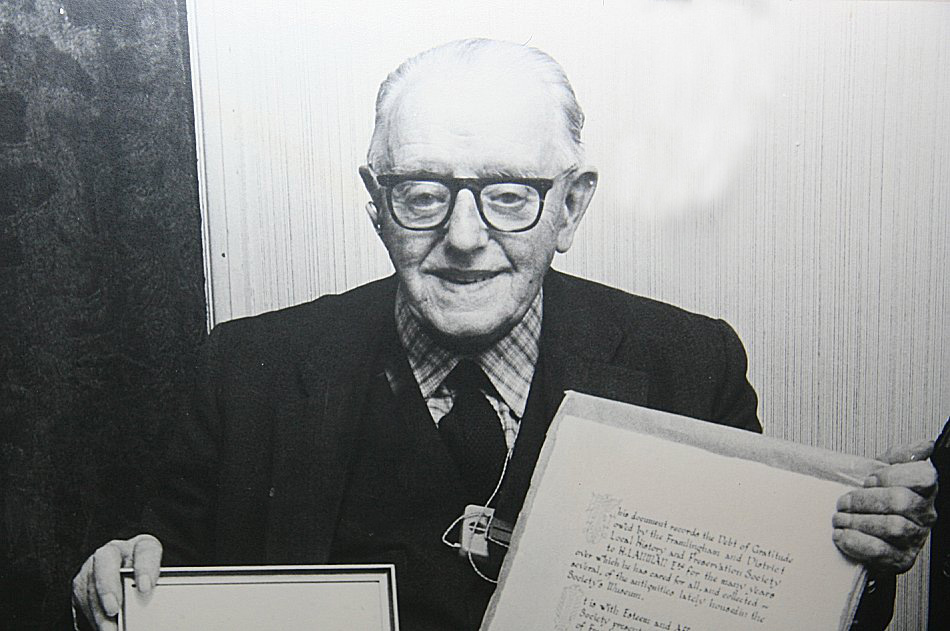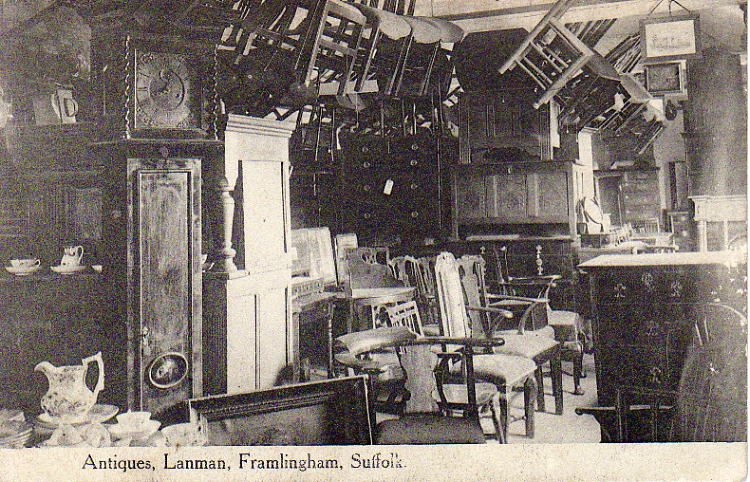
Horace Harold Lanman (1893-1979), usually called Harold, was a long-established dealer of antiques in Framlingham. In the 1930s, he started collecting local artefacts which eventually formed the nucleus of the original Lanman Museum.
Without Harold Lanman’s enthusiasm, expertise and skill, there would not be a museum in its present guise. Harold’s life story emphasises his local origins and the reason for his devotion to the life and times of the people of Framlingham and its surrounding villages.
Harold’s grandfather was John Barker Lanman of Friston post-mill. He moved to a steam mill in Halstead, Essex, before a further move to another mill in Wednesbury. An accident occurred when he was thrown by a steam driving belt onto a millstone, and he died on May 28th 1878, at the age of forty three. John had eight children, which included Harold Lanman, father of our Harold. At the age of fourteen, Lambert senior was established with Charles Percy his uncle, who was a watchmaker in Bridge Street, Framlingham. That arrangement was secured by his grandmother, who died in 1882. There is a Charles Percy long case clock in the Museum.
Harold senior’s experience under the eye of his uncle was not a happy one. He ran away and found lodgings in Castle Street and opened a watch repair and makers shop. He worked very hard and would walk twenty miles a week going to Dennington, Brundish, Wilby, Worlingworth. Tannington, Saxtead and Peasenhall. Charles Percy seems to have been a colourful character who met a tragic end. In July 1887, he was returning from Dennington in his trap when the horse kicked out the floor and he fell through onto the ground. He was dragged along on his knees for some distance and suffered injuries from which he did not recover. Harold took over the watchmaker’s shop in Bridge Street after his death.
He went on to develop a great interest in antique furniture as he travelled around the county. It was an interest which his son Harold was to show so ably. He was born on the 4th November 1893, and his father wrote to his sister announcing that a little dark-haired watchmaker came here this morning at about a quarter past three. Harold’s first memories are of his father moving to a modern shop on the other side of Bridge Street, from his original watchmaker’s premises. In 1902, Harold senior disposed of the watch making and jewellery business and moved to Castle Street where “he will still carry on the business of antique furniture buyer and dealer to which he will now devote his whole time and attention”.
When he was six years old, as a result of an illness his son almost wholly lost his hearing, and lived in a near silent world until he was twelve, when he regained partial hearing. Because of his deafness he spent a great deal of time with his father of whom he had the warmest memories, and was undoubtedly a great influence on his life. He recalled helping with the cleaning of watches which entailed taking the timepieces apart, cleaning the parts with brushes and refined whitening and reassembling. Little wood pegs were used to clean the pivot holes, and this had to be done “as many times as the peg came out dirty”. His deafness had prevented him going to school, and he learnt to read by working his way through Daniel Defoe’s Robinson Crusoe with the aid of a large dictionary.
Harold remarked that he was born among antiques, explaining how he came to be interested in history, and in particular local history. “I had a dream that one day we might have a museum in Framlingham”. The dream led him to ask his father if he could put aside any interesting object which had a connection with the Framlingham district, as they came into the shop. His achievements at a young age were the result of his father wishing to see his son using his hands in a constructive way. He was always seeking to think of something to construct. His stock in trade consisted of a good pair of scissors, a stock of pins and a goodly supply of cardboard.
He was soon making model boats and aeroplanes. When the local hunt assembled in front of the Crown, he was inspired to make models of the huntsmen, hounds and horses. At the age of seventeen he built a model aeroplane that could reach a height of 400 feet, which was reported in the Framlingham Weekly News. This was a sensation with local boys, and he would go on to manufacture them, and placed adverts with the heading “BUY HIM AN AEROPLANE”.
In January 1919, he married Lottie Mallows of Riverside in Framlingham, and they were to have two sons, Philip and John. By the 1930s Harold was firmly employed in the trade as an antiques dealer, and continued to collect artefacts related to the history of Framlingham and its environs. It was in this period that the town held its Pageant, in 1931. This was a spectacular event held over four days. The Pageant office was on the Market Hill (now St Elizabeth Hospice shop), and displayed in the window was a model of the castle and a replica of the Flodden helm, both made by Harold. The original helm is in the Church, while the replica is on view in the Museum.

After the war, Harold’s collection was still growing, and along with the members of the fledgling History Society, this lead to the 1953 exhibition, and then the formation of the Museum. The exhibits are a witness to Harold Lanman’s expertise in deciphering what was of value and interest to the local history of Framlingham, and include many domestic items. Most of the collection dates from the nineteenth century and some much earlier. An important exhibit is the effects of Sir Henry Thompson, an illustrious Framlingham man who became surgeon to Queen Victoria. There is also a considerable collection of prints and paintings, nearly all showing views of Framlingham, including a view by the Norwich school painter Joseph Stannard.
And what of the man? He surely gave the impression on meeting him of being kindly, intelligent, approachable and without pretension. His entire life, from birth in 1893 to his death in 1979 was firmly rooted in the town. He was fully committed to his calling in Framlingham and an expert in his particular field. It is therefore not surprising that his name is remembered, especially as the Museum boasts his name. His marriage of fifty-six years was a happy one. He left two sons, three grandchildren and six great grandchildren.
The Lanman Museum is a fitting tribute to a man who was devoted to the life and times of a town which has been noted as the finest market town in east Suffolk.
This page is based on an article by Andrew Lovejoy and John Bridges written for the Journal of the Framlingham & District Local History and Preservation Society.
Sources
Consultations with Ian Lanman
Archival material in the Lanman Museum office
Article in FRAM, 3rd Series, Number 3, April 1998
A Man and a Museum – Harold Lanman of Framlingham, by Barbara Cotgrove. Suffolk Fair. January 1979
A Short History and Guide for Framlingham by O.R. Sitwell, 1982, page 18
Framlingham Weekly News
